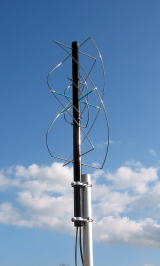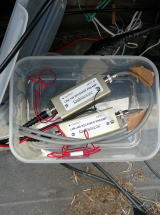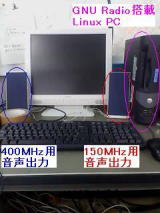|
|
| Design information |
General information
=== Paper for GRBR system ==
Yamamoto, M., Digital beacon receiver for ionospheric TEC measurement developed
with GNU Radio,
Earth Planets Space, Vol. 60, pp. e21-e24, 2008.
http://www.terrapub.co.jp/journals/EPS/pdf/2008e/6011e021.pdf
=== Others ===
Presentation in ISEA-12 Symposium (PDF)
QFH (Quadriliar Helix) Antenna
The 400 MHz element is nested inside the 150MHz element to avoide phase
variation owing to the motion of satellites.
Matching balana is not used. 50-Ohm coax cable is connected to the element
of each antenna at the top.
Pre amplifire (see below) is located at the bottom of this antenna.
GRBR QFH antenna QFH-2B (LARGE PHOTO) is available from the following company. Price is 55000 Japanese Yen
+ Sending, Tax etc.
Nagara Denshi Kogyo Co., Ltd
2876-2 Ichinobe-cho, Higashioumi-shi,
Shiga, 527-0074, Japan
Phone: +81-748-20-1650,
Fax: +81-748-20-1651
Web: <http://www.nagara-ant.com>
E-mail: <info@nagara-ant.com>
=== Links for QFH antenna design ===
Ffabrication guide book (PDF, English)
Design and construction of QFH antennas (design tool is here)
How to make QFH antenna (in Japanese, but many useful figures are here)
QFH antenna information (detailed figures are here, in English)
|

Handmade QFH

Nagara Denshi QFH-2B |
Amplifiers
Pre-amplifires
Hamtronics LNK-146 (tuned to 150MHz, typ. GAIN 18dB, NF=0.6dB) and LNK-400
(typ. 19dB, NF=0.8 dB) are used.
Link: Hamtronics Inc. and its LNK receiver preamp page
Amplifire for 150 MHz
Mini-circuits ZFL-500LN+ (typ. Gain 24 dB, NF=2..9dB) is uesd to adjust
the signal level.
Link: Mini-cuituits Inc. and ZFL-500LN+ datasheet (PDF)
Mini-circuits Yokoyama (One of distributors in Japan)
Filters
Anti-aliasing filters are necessary for both 150 and 400 MHz. We tried
two filteres for our receiver.
Lark Engineering a company for custom-made filters. Very good performance, but relatively
expensive.
Out example: MC150-15-3AA (WO: 26232), MC400-30-3AA (WO: 26233)
Temwell Co. has variety selection of helical BPFs. It is possible to choose appropreate
fileters from their inventory stock. Very inexpensive filter, but performance
should be checked carefully before use.
Our example: TD67281E-152M, K2B-400M-10M (Both 7H2 series, but 7H3 series
may be better.)
|
 |
Software
PC: Typical PC, faster the better. CPS faster than 1GHz may be enough for
observations. TEC estimation is heavy.
LINUX: We like Ubuntu 8.04TLS as most (maybe all) software can be installed without compilation.
(Ubuntu Japanese Team is here.)
Necessary software
For receiver: GNU Radio + USRP (1)
TEC estimation: Scipy, matplotlib, ipython, spe (IDE for Python)
Satellite trajectory calculation: pyephem + tle2azel (see below) (2, 3)
(1) Please read "Build Guide" --> "ubuntu" of the
GNU Radio wiki
(2) "pyephem" can be installed by easy_install. easy_install is included in "python-setuptools" of the ubuntu
8.04LTS package.
(3) Original homepage for "tle2azel" no longer exist on the internet.
Please find it HERE.
TLE (two-line element) of satellite: Celes Trak is useful source of TLE.
|
 |
|
|
|